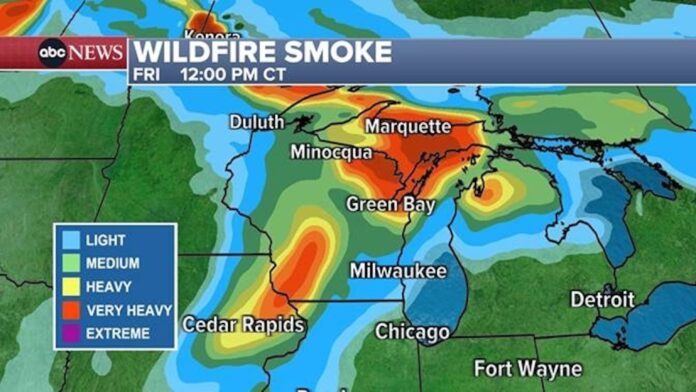An air quality alert was issued across Minnesota, including the Arrowhead region, due to heavy smoke from Canadian wildfires over the weekend of July 12-13. With wildfire smoke becoming a recurring environmental challenge, particularly intense in Cook and Lake Counties on Saturday, July 12, the Northshore Journal sought community feedback on its impact. We reached out to residents via North Shore and Cook County Facebook groups, asking: ‘How is the recent smoke-filled weekend affecting you?
Within a few hours, dozens of responses poured in, offering a spectrum of experiences. While a few comments expressed skepticism about media intentions – one cautioning, ‘The media will twist your words to fit their narrative’ – the majority provided valuable insights into how the smoky skies impacted their lives.
Some respondents veered into broader critiques, ranging from U.S.-Canada relations to unrelated wildfire events. However, many offered direct and thoughtful accounts of the smoke’s effects last weekend.
One resident’s humorous take began with, ‘I saw it outside, so I came back in and took a nap. You can lead with that!”
For many, the impact of the smoke was surprisingly minimal. A local nature photographer, for instance, commented, ‘Just another day looking for wildlife.’ Another longtime Cook County resident likened the air quality to ‘sitting around an evening campfire.’ A young mother reported no issues for herself and her husband, but noted their efforts to keep their 5-month-old safely indoors.
For others, the effects were more severe. Amy Moe-Hoffman of Lutsen described the dramatic reduction in visibility: ‘I was on Cascade Beach and could not even see the Cascade Lodge across the bay. It is only about 1/2 to 3/4 miles from where I was standing. You couldn’t even see an outline of the hills behind Cascade State Park.’ She added, ‘We couldn’t be outside half an hour without feeling sick and lightheaded on Saturday afternoon. It absolutely impacted what we were able to do outside.
Another resident reported a ‘sore throat that felt like someone punched it,’ along with itchy, burning eyes. One gentleman experienced unusual shortness of breath while working in the woods Saturday afternoon.
For those with pre-existing conditions, the impact was more pronounced. One woman with asthma reported proactively wearing an N95 mask when smoke settles, a measure she accepts with grace. Another commenter wrote that the smoke “Kept me indoors all weekend and threw my plans off completely. I have asthma and allergies, both of which were exacerbated.”
The smoke particularly challenged those on supplemental oxygen, who wisely remained indoors until the air cleared. By Monday, relief arrived, as evidenced by one enthusiastic comment: ‘We are at the Cascade River State Park (on Highway 61 in Lutsen), campground full and people everywhere! Nice cool breeze, clear as day!’
Local businesses also felt the pinch. Sandy Maxwell of Maxwell’s Woodland Nursery, located on Lax Lake Road near Finland, closed a half-hour early on July 12, citing nausea and a lack of customers due to the smoke. Carl Madsen, proprietor of Rockwood Lodge and Outfitters on Poplar Lake on the Gunflint Trail, reported, ‘We had a cabin go home early because of the smoke affecting her allergies…’
While woodland wildfires may be less frequent than in past centuries due to human intervention and fire suppression, those that do occur are often far more intense, larger, and destructive. The resulting widespread smoke creates significant societal and ecological impacts. Developing long-term strategies to mitigate the adverse health effects of smoke-filled air should be a priority at all levels of government.
The Minnesota Pollution Control Agency (MPCA) extended the air quality alert until 11 p.m. on Tuesday, July 15. It wrote, “Concentrations are expected to be highest along and near the shores of Lake Superior.”
The air quality index (AQI) has six color-coded levels. On July 12, in the Arrowhead, some areas experienced the Purple Level AQI, one of the most severe levels. MPCA Air quality alerts are issued when the AQI is forecast to reach an unhealthy level, which includes forecasts in the orange, red, purple, and maroon categories. (See the website airnow.gov for a primer on AQI measurement and levels.)
According to the MPCA, fine particle pollution from wildfire smoke can irritate the eyes, nose, and throat, leading to symptoms such as coughing, chest tightness, shortness of breath, dizziness, or fatigue.
Not everyone experiences adverse health effects from unhealthy air quality. Others are either more sensitive to fine particle pollution or have been exposed to larger amounts of it. This diversity of reaction is evident from our informal polling on Facebook, and it’s important to acknowledge and include all these experiences in our community narrative.



